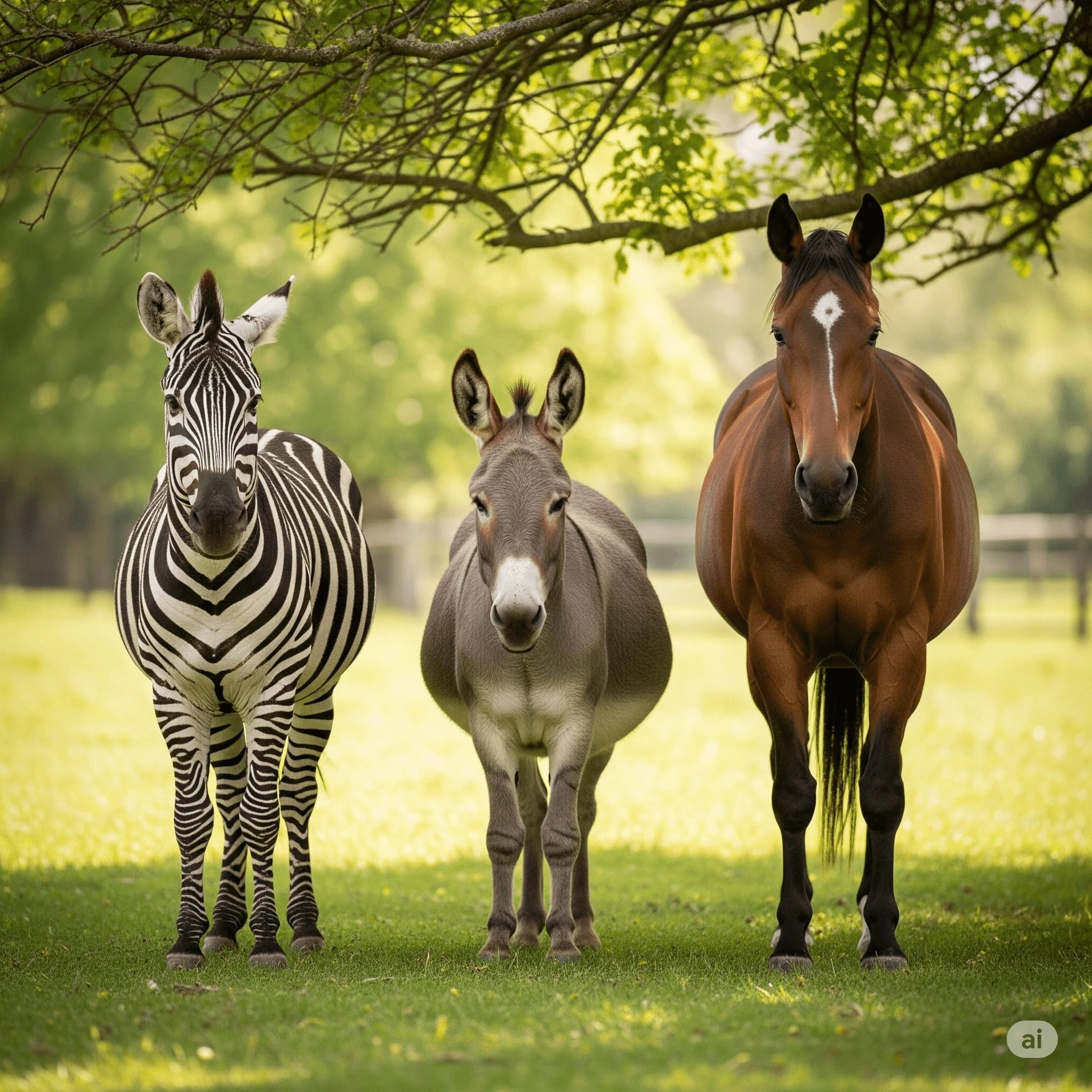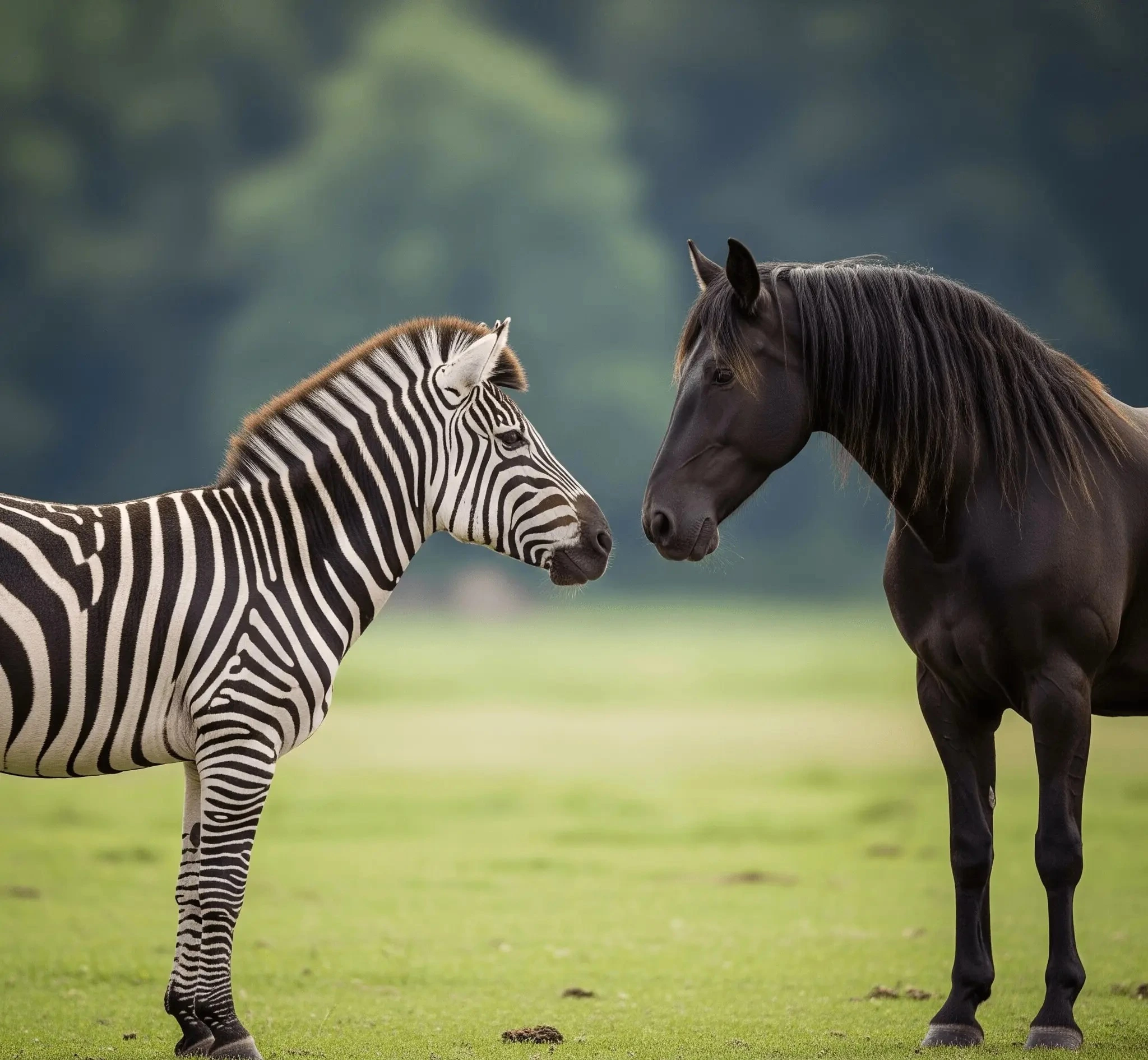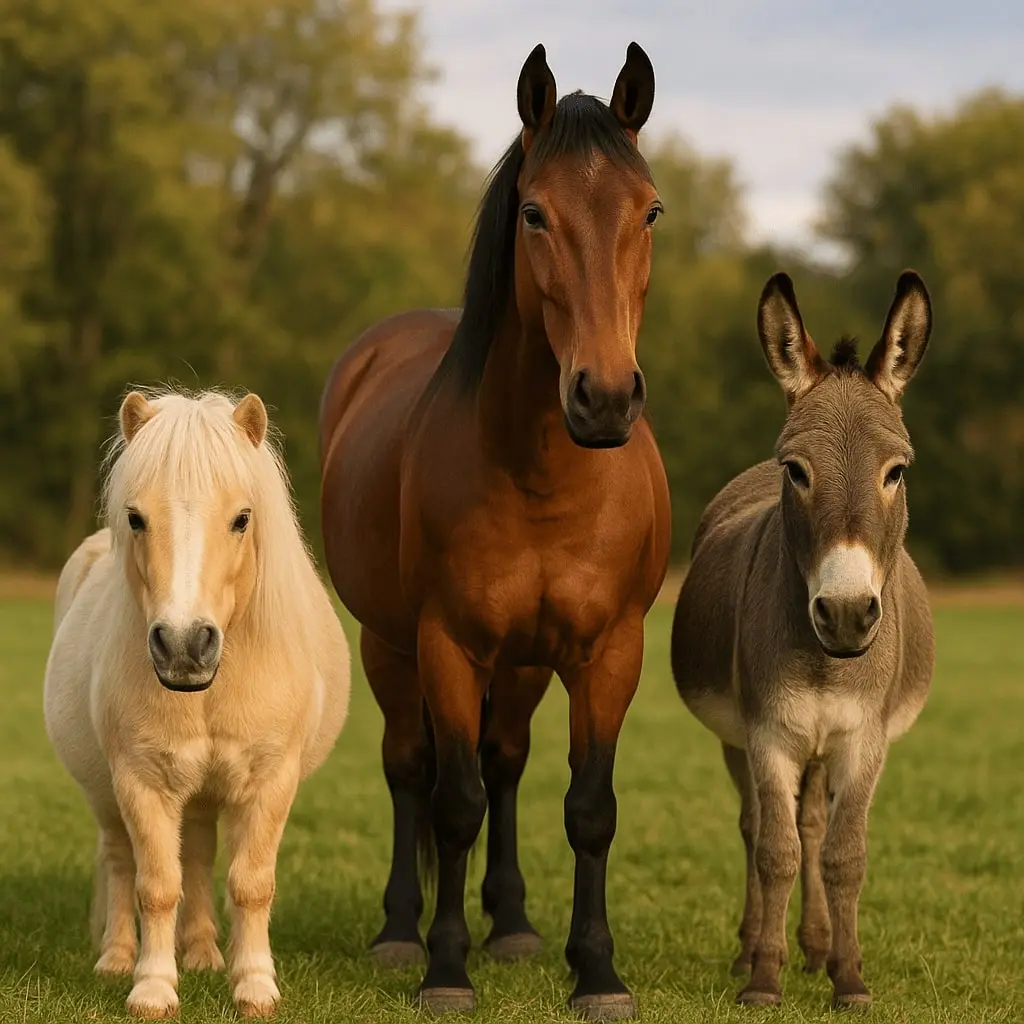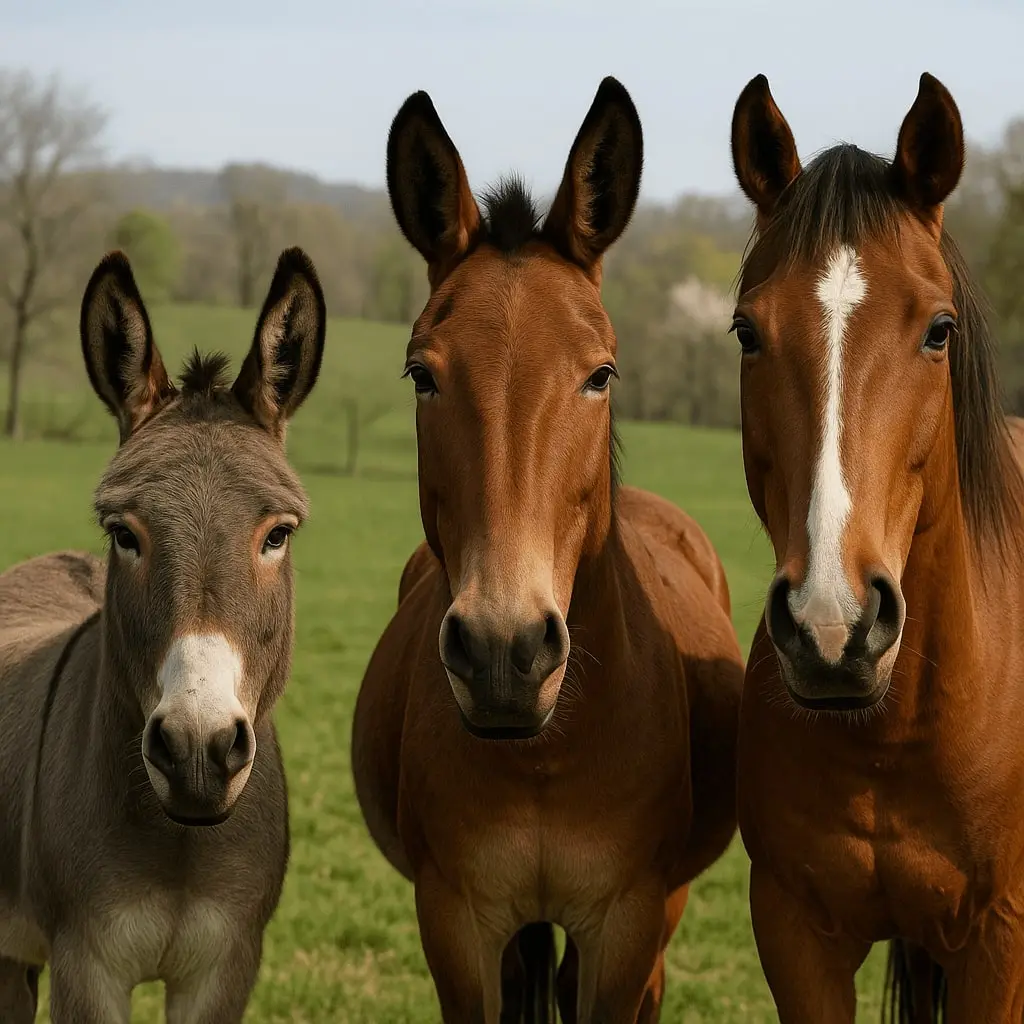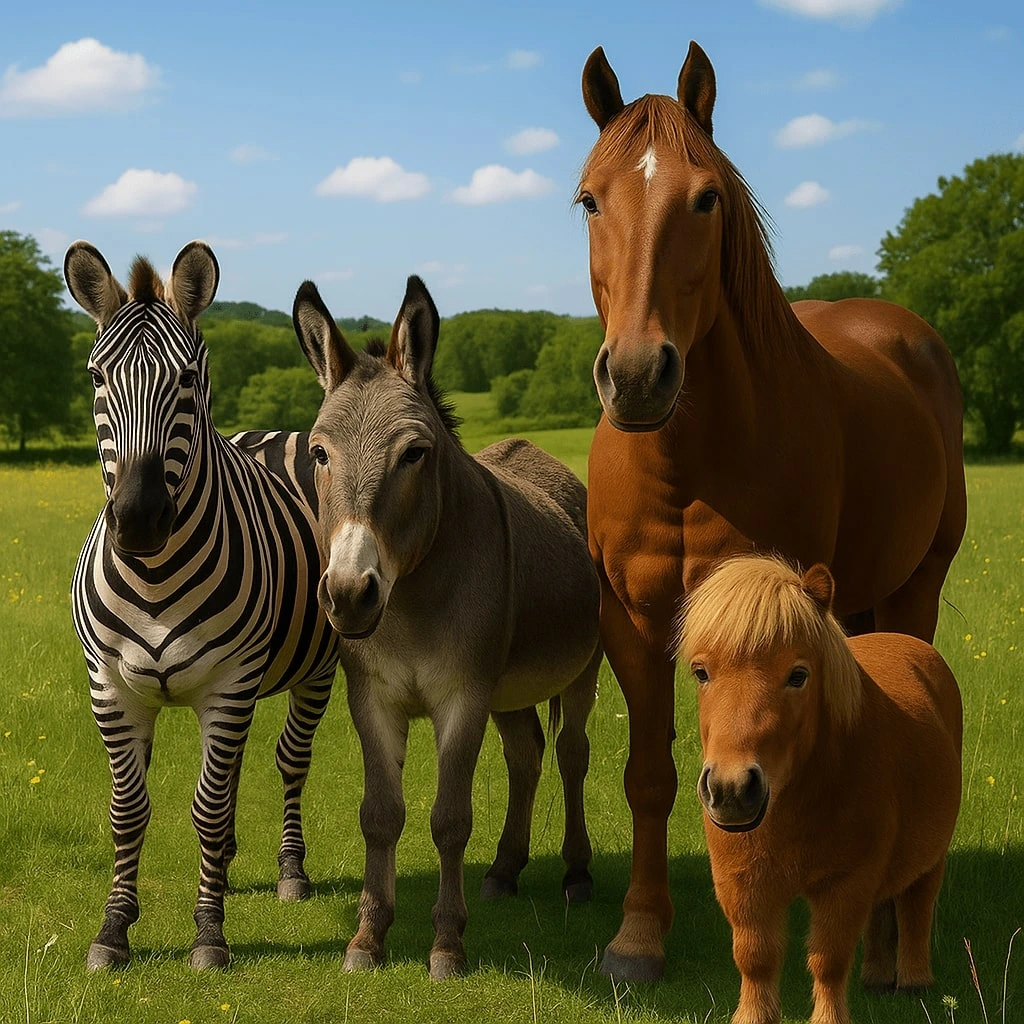When you think of the wild savannahs of Africa, images of zebras grazing under the sun often come to mind. But have you ever wondered how zebras compare to donkeys and horses? These three animals belong to the same family, Equidae, yet they possess distinct characteristics that set them apart. In this guide, we’ll explore the differences between zebra, donkey, and horse, shedding light on their unique features, behaviors, and roles in human history.
Understanding the Equidae Family
Before diving into the specifics of zebra vs donkey vs horse, it’s essential to understand the family Equidae. This family encompasses all modern horse-like animals, including horses (Equus ferus caballus), donkeys (Equus asinus), and zebras (Equus quagga, Equus grevyi, and Equus zebra). Despite their shared ancestry, each species has evolved unique traits suited to their environments and lifestyles.
Zebra vs Donkey vs Horse – Explained!
Let’s now dive in the minor and major species when we studying zebra vs donkey vs horse.
Zebra: The Striped Grazer
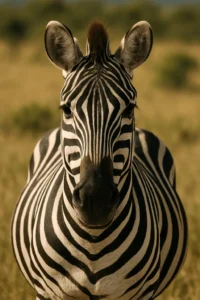
Zebras are perhaps the most visually striking of the equids, known for their distinctive black-and-white striped coats. These stripes are unique to each individual, much like human fingerprints. Zebras primarily inhabit the grasslands and savannahs of sub-Saharan Africa. They are social animals, often found in large herds that provide protection against predators.
Physical Characteristics
- Size: Zebras are generally smaller than horses but larger than donkeys. They typically stand between 3.8 to 5.25 feet tall at the shoulder.
- Stripes: Their black-and-white stripes serve multiple purposes, including camouflage and deterring biting flies.
- Mane and Tail: Zebras have short, erect manes and tufted tails, distinguishing them from horses and donkeys.
Behavior and Habitat
Zebras are herbivores, primarily grazing on grasses. They are known for their strong social structures, with plains zebras living in harems led by a dominant male. Unlike horses, zebras have never been fully domesticated, maintaining a more wild and unpredictable nature.
Horse: The Domesticated Companion
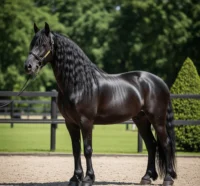
Horses have been companions to humans for thousands of years, serving in transportation, agriculture, and warfare. They are known for their speed, strength, and trainability.
Physical Characteristics
- Size: Horses vary widely in size, with some breeds standing over 6 feet tall at the shoulder.
- Coat Colors: Unlike zebras, horses come in a variety of solid colors and patterns.
- Mane and Tail: Horses have long, flowing manes and tails, which are often braided or groomed.
Behavior and Habitat
Horses are social animals that thrive in herds. They are herbivores, feeding on grasses and grains. Through selective breeding, horses have been domesticated to perform a wide range of tasks, from racing to working on farms.
Donkey: The Hardy Worker
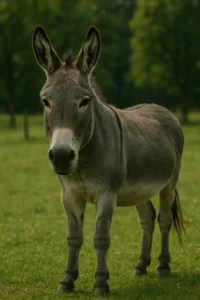
Donkeys, often overshadowed by their larger relatives, are known for their endurance and strength. They have been invaluable to humans as pack animals and companions.
Physical Characteristics
- Size: Donkeys are generally smaller than both horses and zebras, standing between 3 to 4 feet tall at the shoulder.
- Coat Colors: Their coats range from gray to brown, often with a characteristic dorsal stripe.
- Mane and Tail: Donkeys have short, stiff manes and tails with tufted ends.
Behavior and Habitat
Donkeys are native to the deserts of Africa and the Middle East. They are herbivores, feeding on grasses and shrubs. Known for their intelligence and cautious nature, donkeys are often more independent than horses.
Comparing Zebras, Donkeys, and Horses
| Feature | Zebra | Donkey | Horse |
| Size | Medium (3.8–5.25 ft) | Small (3–4 ft) | Large (4.5–6 ft) |
| Coat | Black-and-white stripes | Solid gray, brown, or black | Solid colors or patterns |
| Mane | Short, erect | Short, stiff | Long, flowing |
| Tail | Tufted | Tufted | Long, flowing |
| Domestication | Not fully domesticated | Domesticated | Fully domesticated |
| Social Structure | Herds | Solitary or small groups | Herds |
| Primary Habitat | Grasslands, savannahs | Deserts, arid regions | Grasslands, varied terrains |
Genetic Similarities and Differences
While zebras, donkeys, and horses share a common ancestor, their genetic differences are notable:
- Chromosome Count: Zebras have 32 chromosomes, donkeys have 62, and horses have 64.
- Hybridization: Interbreeding between these species can produce hybrids:
- Zorse: A cross between a zebra and a horse.
- Zonkey: A cross between a zebra and a donkey.
- Mule: A cross between a horse and a donkey.
These hybrids often inherit traits from both parents but are typically sterile due to differing chromosome numbers.
Behavioral Differences Among Zebras, Donkeys, and Horses
- Zebras: Known for their unpredictable nature, zebras are less likely to be tamed compared to horses. They can be aggressive when threatened and are more prone to panic.
- Donkeys: Often perceived as stubborn, donkeys are actually highly intelligent and cautious. They tend to assess situations before acting, which can be mistaken for stubbornness.
- Horses: Horses are social and trainable animals. They have been bred for various purposes, leading to a wide range of temperaments and behaviors.
Roles in Human History
- Zebras: Due to their wild nature, zebras have not been domesticated. However, they have been studied for their unique adaptations and have cultural significance in African art and folklore.
- Donkeys: Donkeys have been essential to human societies, especially in arid regions. They have been used as pack animals, in agriculture, and as companions.
- Horses: Horses have played a significant role in human history, from transportation and agriculture to warfare and sports. Their domestication has had a profound impact on civilizations worldwide.
Scientific Insights
Research into the genetics and behavior of these animals has provided valuable insights:
- Zebra Stripes: Studies suggest that zebra stripes may serve as a deterrent to biting flies and help regulate body temperature.
- Domestication: The domestication of horses and donkeys has led to significant changes in their behavior and physiology, making them more suited to human needs.
- Hybrid Vigor: Hybrids like mules and zonkeys often exhibit traits from both parents but are typically sterile due to genetic differences.
Cultural Significance
- Zebras: In African cultures, zebras are often depicted in art and folklore. Their unique appearance has made them symbols of beauty and grace.
- Donkeys: Donkeys have been featured in various cultures as symbols of humility and perseverance.
- Horses: Horses have been central to many cultures, symbolizing strength, freedom, and nobility.
Genetic Similarities Between Zebra, Donkey, and Horse
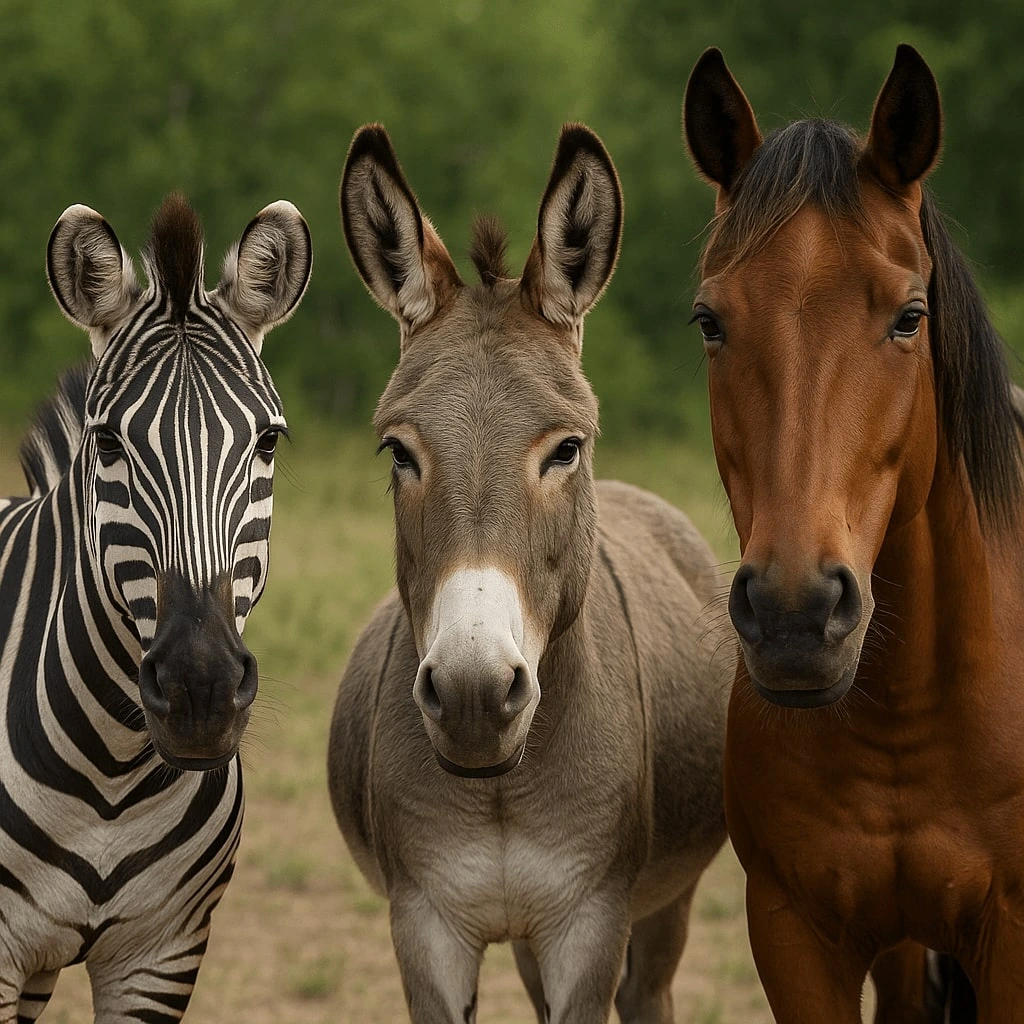
Zebras, donkeys, and horses belong to the same family, Equidae, and share a common ancestor. Despite their differences, they exhibit notable genetic similarities.
Horses (Equus ferus caballus) possess 64 chromosomes, while donkeys (Equus asinus) have 62, and zebras (Equus quagga, Equus grevyi, and Equus zebra) vary between 32 and 46 chromosomes, depending on the species. These differences arise from chromosomal fusions and inversions over millions of years.
Genomic studies reveal that horses and donkeys share approximately 85% of their genes, indicating a close evolutionary relationship. Zebras, though more distantly related, still share a significant portion of their genetic material with horses and donkeys.
These genetic similarities facilitate the possibility of interbreeding among the species, resulting in hybrids like mules (horse-donkey) and zorses (zebra-horse). However, due to differing chromosome numbers, these hybrids are typically sterile.
Understanding the genetic connections among zebras, donkeys, and horses provides insights into their evolution and the complexities of equine hybridization.
How to Tell the Difference Between a Zebra, Donkey, and Horse
Zebras, donkeys, and horses are all part of the Equidae family, but they have distinct characteristics that make them easy to tell apart. Here’s how you can identify each one:
Zebra
- Stripes: Zebras are known for their unique black-and-white stripes, which are different for each individual.
- Size: They are generally smaller than horses but can be longer in body length.
- Mane and Tail: Zebras have short, stiff manes and tufted tails, similar to donkeys.
- Behavior: They are wild animals and are not domesticated.
Donkey
- Ears: Donkeys have long, floppy ears.
- Size: Smaller than both zebra and horse.
- Mane and Tail: Donkeys have short, bristly manes and tufted tails.
- Behavior: Donkeys are known for their intelligence and cautious nature.
Horse
-
- Coat Colors: Horses come in a variety of solid colors and patterns.
- Size: They are generally larger and taller than both zebras and donkeys.
- Mane and Tail: Horses have long, flowing manes and tails.
- Behavior: Horses are domesticated and have been bred for various purposes.
By observing these physical traits and behaviors, you can easily distinguish between a zebra, donkey, and horse.
FAQs
- Can zebras be domesticated?
- Zebras have not been fully domesticated due to their unpredictable nature and strong survival instincts.
- What is a mule?
- A mule is a hybrid offspring of a male donkey and a female horse. Mules are known for their strength and endurance but are typically sterile.
- Why do zebras have stripes?
- Zebra stripes may serve multiple purposes, including camouflage, deterring biting flies, and regulating body temperature.
- Are donkeys and horses the same species?
- No, donkeys and horses are different species within the Equus genus, with distinct physical and behavioral traits.
- What is a zonkey?
- A zonkey is a hybrid offspring of a zebra and a donkey, inheriting traits from both parents but typically sterile.
Conclusion
In conclusion, while zebras, donkeys, and horses share a common ancestry, they possess distinct characteristics that make each unique. Understanding these differences enhances our appreciation for these remarkable animals and their roles in the natural world and human history.

